The Desire to Touch the Past: The Precursor King Exhibit in Toledo
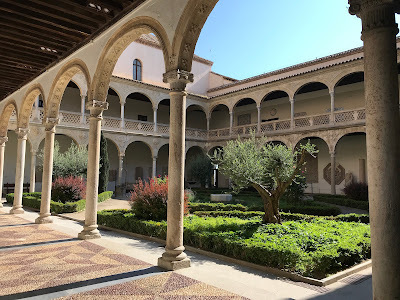 The cloister at the Monastery of Santa Cruz, Toledo,
The cloister at the Monastery of Santa Cruz, Toledo,now the Museum of Santa Cruz
As readers of this blog know, 2021 marked 800 years since the birth of Alfonso X, el Sabio, in Toledo (Spain) on November 23, 1221. I did everything I could to commemorate that important anniversary: going to a concert and exhibits, releasing a book of tremendous importance to me, and presenting that book in Zamora, Burgos, Salamanca, and Benavente.
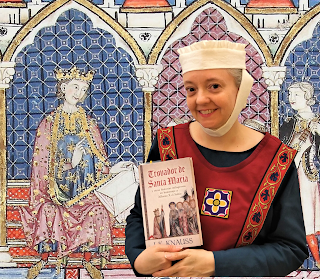 Here we are again on November 23. Happy 801st birthday to the focal point of my scholarly joy!
Here we are again on November 23. Happy 801st birthday to the focal point of my scholarly joy! In May of this year, I had an opportunity to revel in more than 200 objects (pottery, architecture, clothing, manuscripts, recreated musical and scientific instruments, and more!) having to do with Alfonso X, el Sabio, and I think this is an excellent occasion to share some highlights.
I haven't counted, but I think the most celebrations over these two years have taken place in the city of Alfonso's birth. And I have to assume the exhibit Alfonso X: The Legacy of a Precursor King was the most extensive, impressive, and enjoyable.
My mother was with me, and I wore her out looking at everything on offer for a long Spanish morning with excitement that only seemed to increase with every piece. I felt each object in my heart and bones.
The exhibit filled the entire second floor of the Museum of Santa Cruz, and was beautifully organized into moments of Alfonso's life, from birth and family connections, to his early reign, the intellectual projects (the biggest section, of course--we're talking about a certified brainiac), through to the end of his reign, and the impressions of him throughout history since his death in 1284.
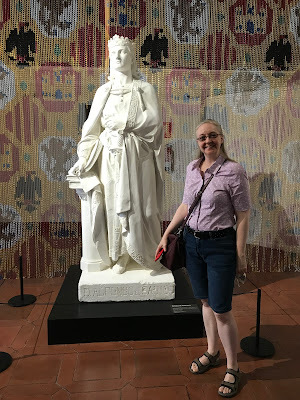 The exhibit started in an anteroom with this lovely model for a nineteenth-century statue that was never completed. I took the opportunity to be photographed with a handsome physical representation of this person I will never meet in life.
The exhibit started in an anteroom with this lovely model for a nineteenth-century statue that was never completed. I took the opportunity to be photographed with a handsome physical representation of this person I will never meet in life. 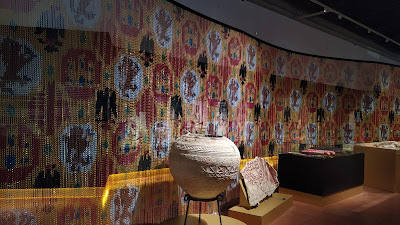 The bead curtains in the background were used throughout the exhibit to separate the sections and highlight the pieces. The intense colors, translucent glow, and symbols of royalty made this visitor feel like she was walking into an Alfonsine manuscript.
The bead curtains in the background were used throughout the exhibit to separate the sections and highlight the pieces. The intense colors, translucent glow, and symbols of royalty made this visitor feel like she was walking into an Alfonsine manuscript.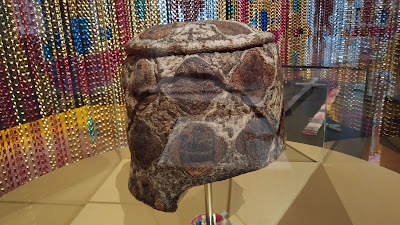 One representative of Alfonso's early family life was his brother, Prince Felipe. This linen and silk bonnet was removed from his tomb in Villalcázar de Sirga. The colors have darkened over time, but the castles and lions, emblems of the prince's royal status, are still visible.
One representative of Alfonso's early family life was his brother, Prince Felipe. This linen and silk bonnet was removed from his tomb in Villalcázar de Sirga. The colors have darkened over time, but the castles and lions, emblems of the prince's royal status, are still visible. When you work mainly with texts, your heroes are ephemeral collections of thoughts and ideas. Anything that gives evidence of that hero's physical existence, even if it was 800 years ago, is the closest thing we have to traveling in time.
Closed tombs, architecture where they lived, or pottery they might've used become a concentrated blast of emotion accumulated over years of study. If possible, clothing is an even more intense sensory experience.
Clothing so rarely survives because it's so delicate, and it is one of the most intimate things any person will ever use. Being so close I could touch the threads and smell the earthiness of the silk and metallic gold, and imagining this very hat on the head of Alfonso's brother... and ones just like it on the head of the king himself... Simply overwhelming.
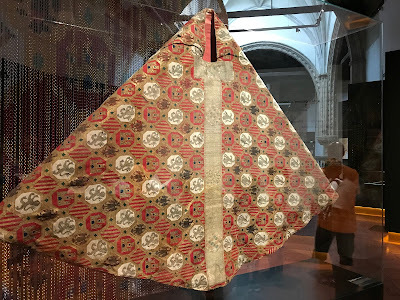 Unlike the hat, this cape retains all its original splendor. Probably a gift from Alfonso X to his brother-in-law, Prince Sancho, when Sancho was made Archbishop of Toledo (the most important ecclesiastical role in medieval Spain), the cape's silk and gold threads show the symbols of Castile and León (Alfonso's kingdom), Aragón (Prince Sancho's kingdom of origin), and the eagle of the Staufen family in memory of Alfonso's mother, Beatriz of Swabia.
Unlike the hat, this cape retains all its original splendor. Probably a gift from Alfonso X to his brother-in-law, Prince Sancho, when Sancho was made Archbishop of Toledo (the most important ecclesiastical role in medieval Spain), the cape's silk and gold threads show the symbols of Castile and León (Alfonso's kingdom), Aragón (Prince Sancho's kingdom of origin), and the eagle of the Staufen family in memory of Alfonso's mother, Beatriz of Swabia. 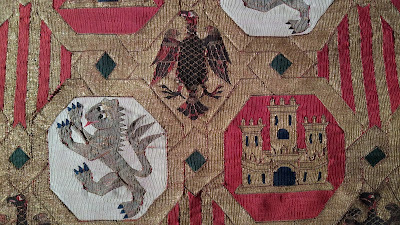 This closeup shows itsintricate detail and solid embroidery. It had to have been created by a team of royal tapestry-makers, and it's so intact, it must hardly have been used and been stored in very fortunate conditions. The bead curtains we were "wrapped" in the whole time are based on this pattern.
This closeup shows itsintricate detail and solid embroidery. It had to have been created by a team of royal tapestry-makers, and it's so intact, it must hardly have been used and been stored in very fortunate conditions. The bead curtains we were "wrapped" in the whole time are based on this pattern. 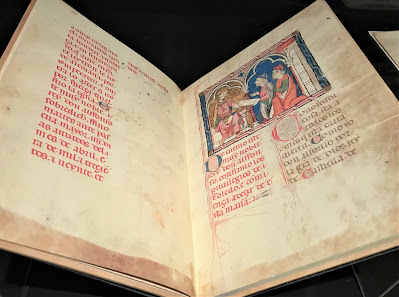 The Book of the Privileges of Toledo, late thirteenth century, is a deluxe manuscript to ensure no one forgot exactly what rights and benefits Toledo had from the king. The miniature shows Alfonso X granting these privileges to grateful Toledans, yet another representation of the king doing his job with due generosity.
The Book of the Privileges of Toledo, late thirteenth century, is a deluxe manuscript to ensure no one forgot exactly what rights and benefits Toledo had from the king. The miniature shows Alfonso X granting these privileges to grateful Toledans, yet another representation of the king doing his job with due generosity. 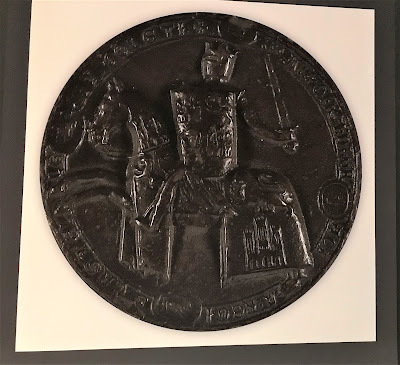 I have a cherished replica of this seal at my home in the United States. In the Middle Ages, seals of authentication were large and hung from the documents by a cord. This wax seal is as big as the palm of an "average" man's hand and shows Alfonso X riding into battle.
I have a cherished replica of this seal at my home in the United States. In the Middle Ages, seals of authentication were large and hung from the documents by a cord. This wax seal is as big as the palm of an "average" man's hand and shows Alfonso X riding into battle. Medieval Spanish kings were expected to be able warriors and participate in whatever important battles came up. Though we no longer emphasize this aspect when remembering him, Alfonso X took active part in many battles, including helping his father win important cities in the south while he was still prince. His declining health in later years and extraordinary intellectual accomplishments are what people emphasize about him. Every once in a while it's good to recall that Alfonso X never shirked his physical duties, either.
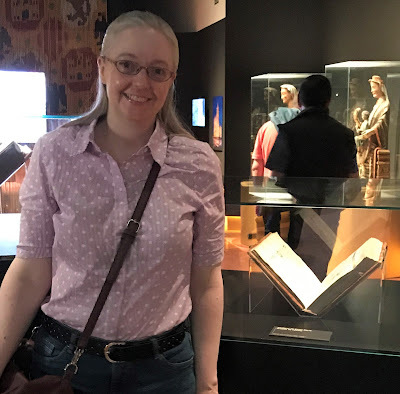 Here I am with the To codex of the Cantigas de Santa Maria. Remember what I wrote about clothing being so personal? In Alfonso X's case, Cantigas manuscripts, which he definitely commissioned, may have edited and approved, and certainly physically touched to refer to when complete, are probably the most personal physical object possible.
Here I am with the To codex of the Cantigas de Santa Maria. Remember what I wrote about clothing being so personal? In Alfonso X's case, Cantigas manuscripts, which he definitely commissioned, may have edited and approved, and certainly physically touched to refer to when complete, are probably the most personal physical object possible. The only reason my head didn't explode at this point was that I had already seen this very codex in February in Madrid at the National Library. That day I saw so many of the manuscripts I've spent decades admiring from afar that I broke down sobbing for a few minutes. With that out of the way, in May I had emotional space to take in this manuscript again and all the new-to-me wonders, as well. It's an accomplishment!
The To codex was open to a different page for this exhibit than it had been in Madrid. Significantly, it displayed Cantiga 12, which takes place in Toledo.
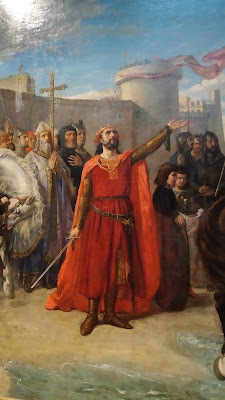 Alfonso X enters Cádiz and takes possession of the sea in this lively nineteenth-century painting that won the artist, Matías Moreno, a gold medal. This painting was at the entrance to the document-heavy section of the exhibit, so perhaps it served to remind visitors that these documents are not merely dry ink on vellum. They depict exciting events, many of which had centuries-long repercussions.
Alfonso X enters Cádiz and takes possession of the sea in this lively nineteenth-century painting that won the artist, Matías Moreno, a gold medal. This painting was at the entrance to the document-heavy section of the exhibit, so perhaps it served to remind visitors that these documents are not merely dry ink on vellum. They depict exciting events, many of which had centuries-long repercussions. 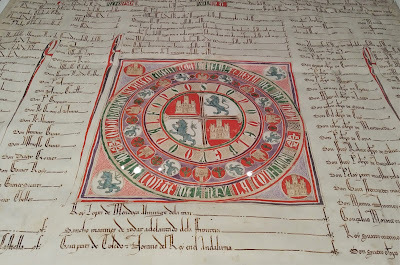 Many legal documents display these beautiful circular symbolic royal signatures for a validation that's obvious to anyone who looks at it. This royal circle, especially deluxe with its rich reds, greens, black, and gold, is from a May 24, 1256, privilege granting coin minting to the archbishop and council of the Cathedral of Toledo.
Many legal documents display these beautiful circular symbolic royal signatures for a validation that's obvious to anyone who looks at it. This royal circle, especially deluxe with its rich reds, greens, black, and gold, is from a May 24, 1256, privilege granting coin minting to the archbishop and council of the Cathedral of Toledo.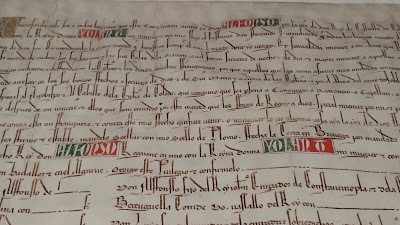 A closeup of the same document shows the king and queen's names highlighted in green and red. I have a feeling I'll be discussing Queen Violante more on this blog in the coming months.
A closeup of the same document shows the king and queen's names highlighted in green and red. I have a feeling I'll be discussing Queen Violante more on this blog in the coming months. 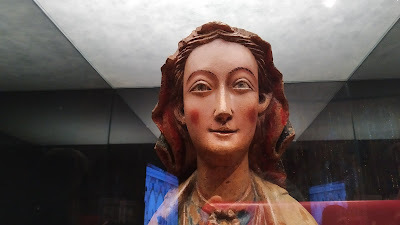 A painted wooden St. Mary of the Navarra school, late thirteenth century, is a three-dimensional example of the aesthetic found throughout the Alfonsine manuscripts.
A painted wooden St. Mary of the Navarra school, late thirteenth century, is a three-dimensional example of the aesthetic found throughout the Alfonsine manuscripts. 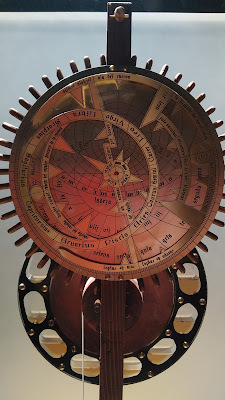 In the astronomy section, some of the most impressive pieces were reconstructions of the instruments described and illustrated in the Alfonsine books that measure the phenomena of the night sky. Eduard Farré recreated this Mercury clock, which shows the movement of the constellations, based on the Book of Knowledge of Astrology.
In the astronomy section, some of the most impressive pieces were reconstructions of the instruments described and illustrated in the Alfonsine books that measure the phenomena of the night sky. Eduard Farré recreated this Mercury clock, which shows the movement of the constellations, based on the Book of Knowledge of Astrology.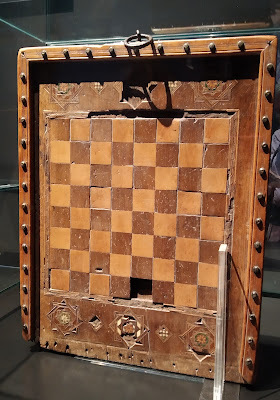 The most diligent intellectuals are the people most in need and deserving of taking a little break now and then. This philosophy is found at the beginning of the Book of Chess and Board Games (1283), the last book Alfonso X commissioned. This chessboard from fourteenth-century Granada looks like it came out of an illustration from that book. It's practical, with storage for the pieces and a way to secure and carry it wherever it's needed for some clean fun.
The most diligent intellectuals are the people most in need and deserving of taking a little break now and then. This philosophy is found at the beginning of the Book of Chess and Board Games (1283), the last book Alfonso X commissioned. This chessboard from fourteenth-century Granada looks like it came out of an illustration from that book. It's practical, with storage for the pieces and a way to secure and carry it wherever it's needed for some clean fun. 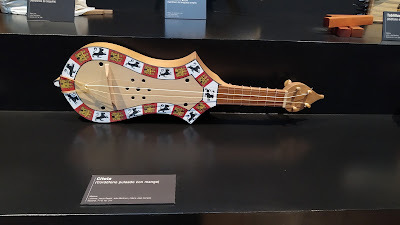 The exhibit boasted an enormous altar of musical instruments recreated from illustrations in the Cantigas manuscripts. Jesús Reolid, Jota Martínez, and María José Campos crafted this lovely citole, accurate down to the castles and lions.
The exhibit boasted an enormous altar of musical instruments recreated from illustrations in the Cantigas manuscripts. Jesús Reolid, Jota Martínez, and María José Campos crafted this lovely citole, accurate down to the castles and lions. 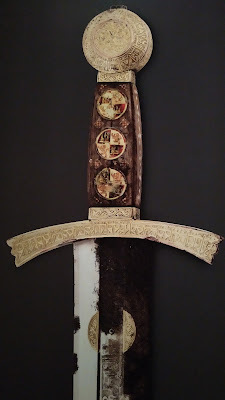 After a somber section describing Alfonso X's difficult final years and death, but that also provided a video summary of his accomplishments, the exhibit featured what turned out to be the star items. When they opened the tomb of Sancho IV, Alfonso's second son and successor, in 1947, the scholars rescued many items Sancho had been buried with. The first on display was this spectacular sword.
After a somber section describing Alfonso X's difficult final years and death, but that also provided a video summary of his accomplishments, the exhibit featured what turned out to be the star items. When they opened the tomb of Sancho IV, Alfonso's second son and successor, in 1947, the scholars rescued many items Sancho had been buried with. The first on display was this spectacular sword. I don't think I would be so into medieval Spain or swords if I hadn't adored The Princess Bride as a preteen. This kind of thing still has plenty of capacity to delight me. This sword is regally decorated and must have rested in Sancho's hand on any number of occasions. It's another very personal item for that reason.
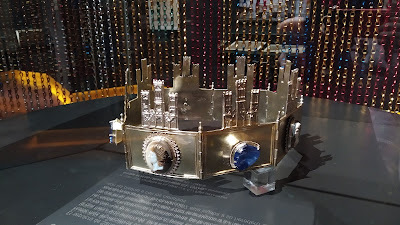 The piece I had been longing to see came at the end. Another item extracted from Sancho's tomb, this is the only medieval Spanish king's crown that we are aware of having survived to the present day. The only one! And it seems extraordinary.
The piece I had been longing to see came at the end. Another item extracted from Sancho's tomb, this is the only medieval Spanish king's crown that we are aware of having survived to the present day. The only one! And it seems extraordinary. I love the ingenious way the castles serve as the peaks. There's no pictorial evidence that this was the usual way to design a crown. The large precious stones, however, are typical. The cameos aren't a medieval specialty, but it was very medieval to repurpose Roman cameos. I think these cameos were probably already antique when they were set into the crown. The hinges so it could adapt to different heads and headwear are another delightful surprise. The king would've worn a soft hat, often of velvet, and placed this crown on top.
Here's the thing. Though it was found in Sancho's tomb, it's pretty clear Alfonso X used this crown before his son did. Alfonso's 1282 testament granted his heir "the crown with stones and cameos." Most scholars agree it makes sense that he's referring to this crown, the only one that survived the Middle Ages to our time.
I would've bought a reasonably accurate replica of this crown, no questions asked, no matter the cost. Even though I had no room in my suitcase after my mom had brought me a couple of things from the United States and three weeks of travel. Even though I have nowhere to put it in my apartment. I would've found a place.
But no replica was available, and so I went home with just a great CD of Cantigas by the Jota Martínez Ensemble.
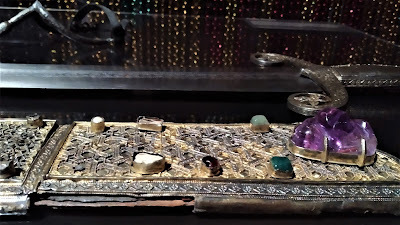 Granular closeup of a bejeweled sheath said to accompany a
Granular closeup of a bejeweled sheath said to accompany a sword belonging to "Roland." Since it's from 1250 and part
of the royal treasury, it's likely Alfonso X, his father, and his son
were the actual owners of this sword.
After a wonderful visit, I've been reading about the Romanesque art of the cathedral of Santiago de Compostela. Maestro Mateo, the designer, was kind enough to sculpt a near-life-size statue of Santiago the pilgrims could approach and wrap their arms around. In this way, they tangibly experienced the object of a devotion so strong, they left their homes and walked for months in its honor.
This was nearly a thousand years ago, so it has nothing to do with modern commercialism, but with a deep-seated need for humans to bring their interior hopes and dreams into exterior reality.
I've left the place of my birth and have been on this Alfonsine journey much longer than it takes to walk the Camino de Santiago. Of course I want tangible evidence of my decades of study. The Precursor King exhibit has been the event that came closest to fulfilling that desire.
But I wasn't able to literally touch any of the books, clothing, instruments, or metalwork. The saga continues...
Thanks for letting me share a small part of my joy with you.
Further reading:
Our Lady's Troubadour
Law and Order in Medieval Spain



